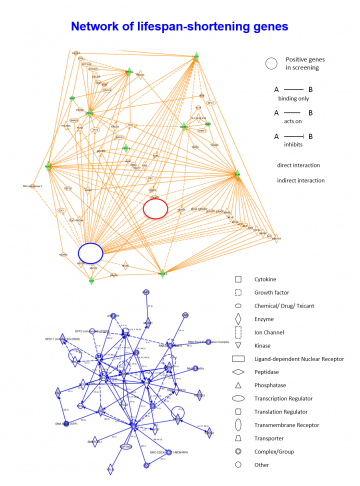Intellectual disability gene PQBP1 affects lifespan (2012)

We used systems biology to analyze the pathological network of abnormal gene expression profiles in dPQBP1 mutant flies.
PQBP1 (polyglutamine binding protein-1) was originally identified by our group as a new factor binding to polyQ tract sequence by yeast two-hybrid screening. PQBP1 is now shown to be a nuclear protein involved in transcription and splicing. It is a component of spliceosome and shuttles to cytosol and forms stress granule when cells are under stress. PQBP1 mutations cause one of the most frequent intellectual disability / mental retardation diseases (ID/MR). We investigated the relationship between phenotypes and PQBP1 gene expression levels in order to prepare for the future therapeutics.
Previously we made PQBP1 mutant fly that possesses transposon insertion within Drosophila homogue PQBP1 (dPQBP1) gene. Expression was extremely decreased and the fly showed learning disturbance. We newly found that lifespan of the mutant fly was shortened. We asked relationship of dPQBP1 expression level and lifespan or learning ability with various rescue flies using neuron-specific or general drivers, and finally found that optimum level of PQBP1 expression exists near the normal level. Below the normal expression level, lifewspan and learning ability are both decreased. Above the normal level, lifespan is shortened but learning ability remains normal. The knockdown of PQBP1 in neurons does not remarkably affect lifespan but general knock down using tubulin-driver induces remarkable ahortening of lifespan.
These results indicate that normal or excessive expression of PQBP1 in neurons is not harmful, while the excessive expression in non-neural tissues might be harmful. The knowledge will be useful for future development of therapeutics against the PQBP1 spectrum of ID.

